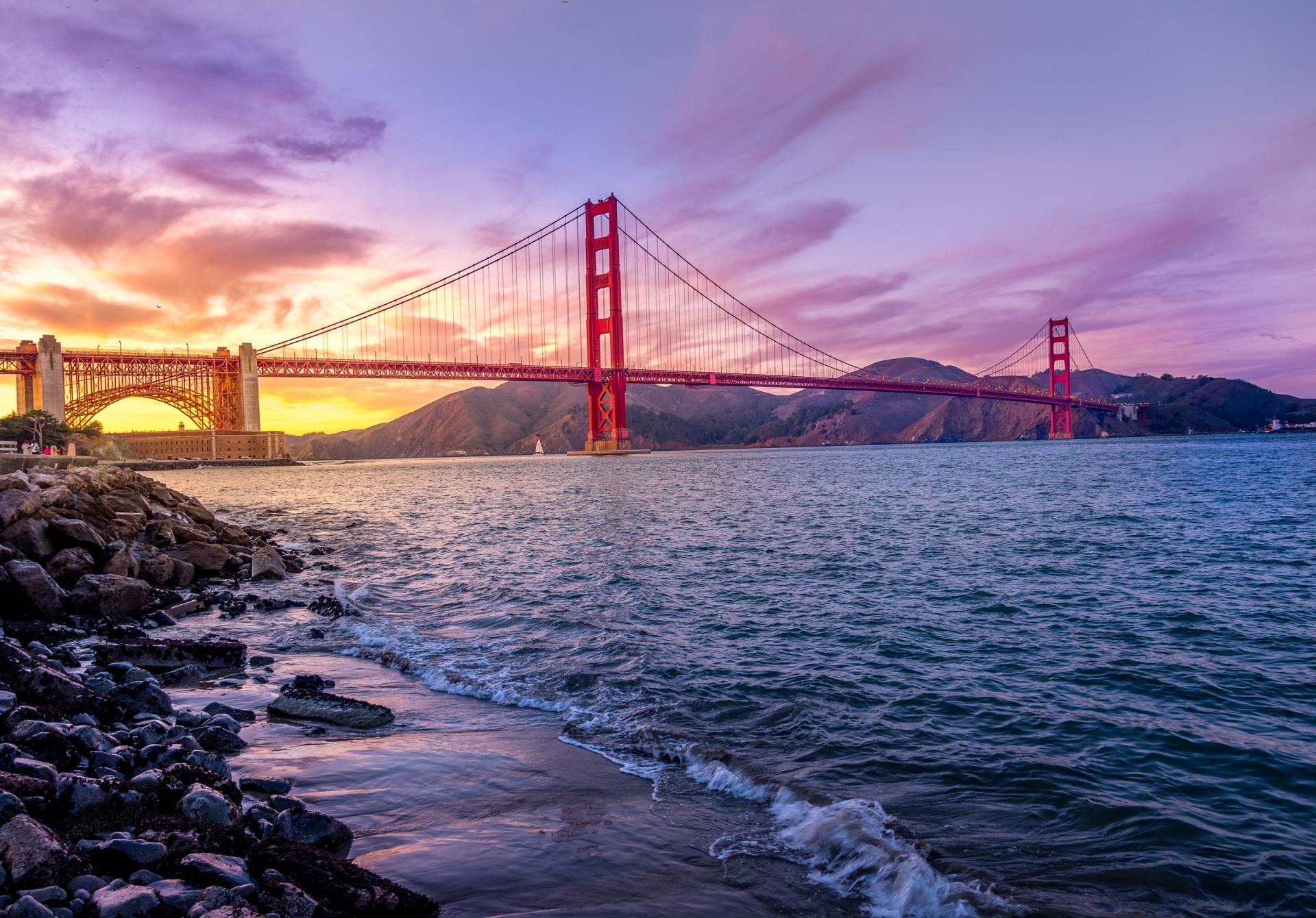
Sierpinski Mountains II , 2012, spray paint, pencil, color pencils on cyanotype, 22 x 30 inches
Using photography’s processes as a point of departure, Christine Nguyen’s pioneering spirit led her to begin manipulating negatives and onward–creating her own by cutting, layering, and adding on. Nguyen’s subsequent explorations embrace drawing and object making alike, each body of work permeated with a sense of profound discovery. —Julie Dickover
AL
You went to California State University Long Beach for your BFA in Photography, and University of Irvine for your MFA in Studio Art. How did the evolution as a straight photographer to an artist who performs wild experiments with the medium take place?
CN
I developed my photo-based process during my last semester at CSULB. I started to draw on pieces of Mylar and use them as negatives. I did not draw much back then and it wasn’t until grad school where I really focused on drawing more. I have always been a maker and creator of things and have been interested in object making as well as sculpture.
AL
What prompted you to start drawing? How did you make that leap to using the drawings as negatives?
CN
I have always been interested in drawing and painting, but somehow I was more drawn to photography, maybe due to its chemical and mechanical process. Because I was a “photo major,” I thought I had to keep the two separate until a light turned on, and I realized I could combine the two.
Details from early photo-based work, positive and negative image
AL
I first became acquainted with your work when you did a large photomural for the lobby wall at the Hammer Museum in Los Angeles in 2006. Could you describe the process for this?
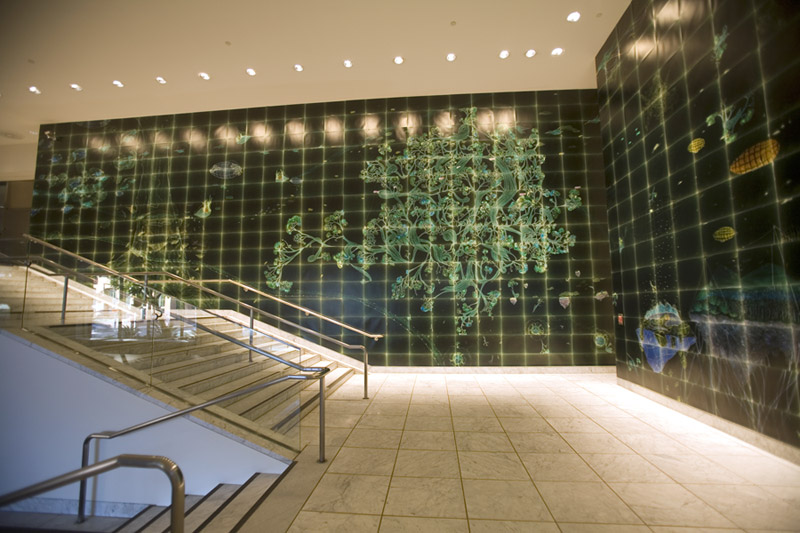
Migration over the Woods and Its Strange Powers, 2006, c-prints, installation view of middle lobby wall, 251 x 579 1/2 inches, Hammer Museum, Los Angeles
CN
I take layers of drawings on Mylar, cut them into strips and use them in a photographic enlarger to be printed. The end result is a negative image of the drawing, similar to that of a photogram.
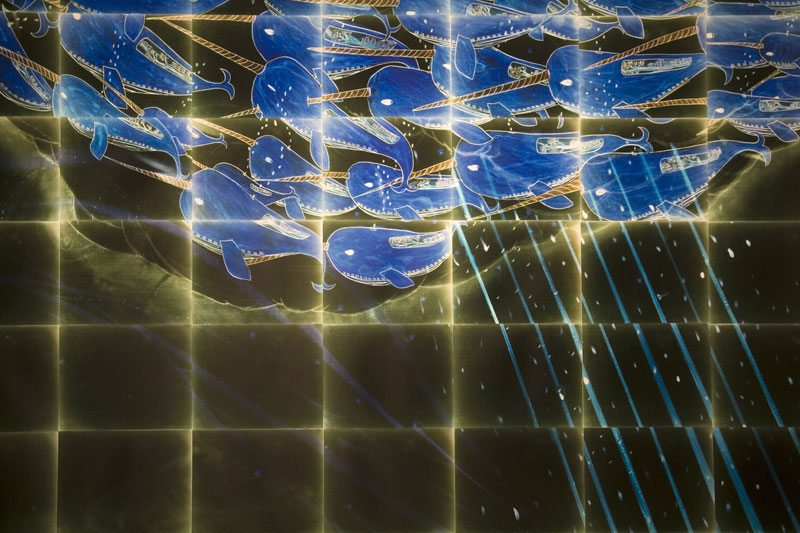
Migration over the Woods and Its Strange Powers, 2006, c-prints, detail of top lobby wall, 151 x 159 1/2 inches, Hammer Museum, Los Angeles
This was the largest photo-based piece I had made. It was site-specific and measured out to the Hammer’s lobby walls. The most difficult part was working around the staircase wall. I had to estimate and then cut the pieces to fit around the railing and staircase. I had used the three walls as if the piece was a floating triptych. I imagined the largest wall at the bottom of the staircase to have airplane bird-like creatures flying out of the scene onto the staircase wall, which then transformed into magic narwhals that contained other worlds, at the top.
AL
Was there a lot of trial and error when you first began making large wall murals? Were there failures, or pieces that didn’t translate very well to a larger scale?
CN
Oh, you should see the early work! It looks very different. I was using clear acetate and was doing more like collages and only using sharpies, since it was the only thing that would adhere to this type of clear acetate. I soon discovered Mylar that I could draw on, which changed everything. It began to look less like collage as I really started to draw and paint and work on the surface more.
AL
Layering seems to be integral to your practice, and you use it with a variety of materials and tools. What about the quality of layering draws you to it?
CN
I like creating a depth in my works, and including all my various interests in materials and process into one piece. Building onto it.
AL
Was there something about the lack of layering in straight photography that led you to experiment with the Mylar?
CN
I think even when I was doing straight photography I was interested in experimenting with the medium. I was already sandwiching negatives or experimenting by laying patterned acetate on top of photo paper. The Mylar, come to think of it, is an extension of that investigation which I haven’t thought about in many years!
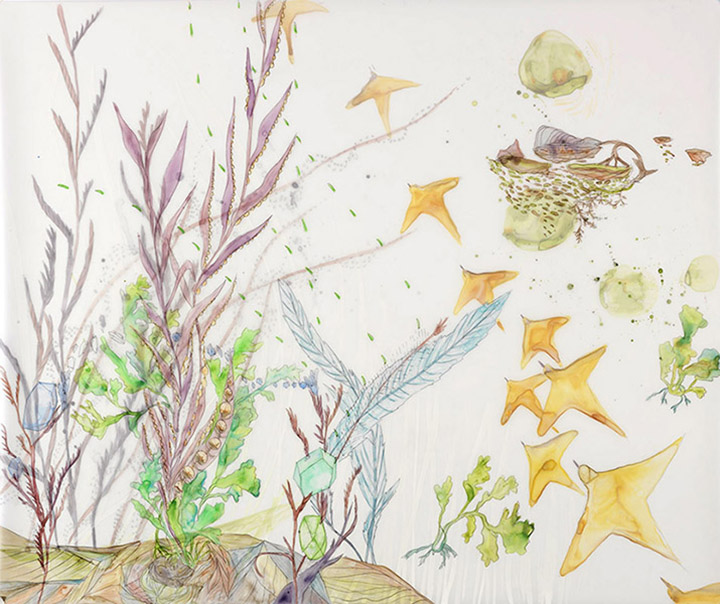
Rockweeds, 2009, mixed media on Mylar, 22 x 26 inches
AL
In those earlier works, as well as some of the work you are making now, you incorporated fantastical themes that demonstrate an interest in a variety of subjects – science, astronomy, geology, marine biology, for example. Did you ever think about being a scientist?
Blue Boats Flying, 2012, mixed media on layered Mylar, 18 1/2 x 22 inches
CN
I have always had an interest in being a marine biologist, astronomer, chemist or archaeologist as a kid. My father was a commercial fisherman growing up in California. I was exposed to various things from the sea that my dad would bring home or I would see it on his boat. I think that played a role in my fascination with the ocean.
AL
I like the idea of you as this Jules Verne-ish artist who is an explorer, archeologist and scientist dreaming up these new worlds. Are you into science fiction? Do you read a lot about these other areas of knowledge?
Powers of the Cosmic Dusty Seas, 2011, detail, c-prints, Crisp-Ellert Art Museum, St. Augustine, FL
CN
I like science fiction, but I can’t say I’ve read a lot of it. I do love Star Trek and have watched all of the series. I am definitely interested in reading about new scientific discoveries and research, but can’t say I’m well-versed in the subject. I get inspired and draw from the things I read that’s for sure.
AL
You also make cyanotypes. When did you first begin making those, and what appeals to you about that process?

Drops, 2010, cyanotype and salt crystals on paper, 15 x 22 inches
CN
I actually learned how to make cyanotypes when I was an undergraduate. I had not made any more until just a few years ago, so there’s a big gap. I was first drawn to the process when I would make them on day trips to the woods or desert. The outdoors became my studio and I was really drawn to that. The idea of using sunlight to make the cyanotypes also fit perfectly with my work as it related to process and nature.
Untitled II (aerial view), 2010, cyanotype and salt crystals on paper
AL
Around this time you began your ongoing experimentation with salt crystals. Could you talk about some of these works?
Untitled, 2008, dried plant and salt crystals
CN
I began experimenting with salt crystallization when I was collecting seaweed. One day I noticed as the seaweed dried, small salt crystals had formed from the ocean water. It triggered something in me and I went on a salt crystal growing frenzy. I was reading about it and the various ways you can grow it. I started to grow salt crystals on collected objects and saw the different ways it can grow on vegetation. My first salt crystal works were in 2008. I managed to grow a cube shaped salt crystal on a dried plant.
What the Ocean Left Behind, 2009-2011, installation detail, collected debris from California and Florida, salt and borax crystals, glass bell jars, Crisp-Ellert Art Museum, St. Augustine, FL
AL
The “Crystalline Capsule” from your 2011 residency at the Montalvo Art Center is beautiful. Not only are the objects you’ve encrusted with various crystals visually stunning but also the installation itself contains a sense of mystery, like you’ve happened upon a world that has been frozen in time.
Crystalline Capsule, 2011, colored acrylic and salt crystallized vegetation, Montalvo Art Center
CN
I feel the crystallization process is similar to preserving the object, but also at the same time it does degrade it since salt really can break down things. It is frozen and encapsulated until the environment changes and the salt crystal structure changes.
AL
In the past several years you’ve explored crystallizing objects as well as cyanotypes and photographs. You still synthesize a lot of the methods and materials from your previous works, salt crystals, plant life, and photo-based processes, but you now also incorporate spray paint and paper folding into the newest works. The imagery is more abstract. How do you feel the work with crystals has changed?
CN
I do feel like it has changed, but I am still interested in all the other methods of working. The paper fold piece is more about capturing light and the slippage of time. This still relates to the crystals, with light refracting and the paper fold crystalline patterns. I feel like the new work is developing a more abstract language while still maintaining that otherworldly feel.
First Light, 2013, paper cranes folded from Somerset Velvet paper, spray paint, and salt crystals, 110 x 110 inches
AL
From 2010 to 2013 you collaborated with the artist Daniel Man on a series of drawings. What was it like to collaborate with someone, and how did it come about?
CN
Daniel Man is an awesome artist that lives in Munich, Germany. I met him when I was in a group show at Sprueth Magers in 2007 and have kept in touch with him over the years. I saw him again in a couple years later on a research trip to Germany. We connected and both have similar sensibilities and so we decided to send drawings back and forth.
 Collaboration with Daniel Man, 2010-2013, mixed media on paper
Collaboration with Daniel Man, 2010-2013, mixed media on paper
AL
Did you have any ground rules, or were you both open to however things turned out?
CN
We both kept things very open and the resulting works were these visual conversations with each other. Because we felt like our own bodies of work and personalities connected, it was easy for us to have these conversations without verbally discussing anything. It was all very intuitive.
AL
Could you describe your collaboration with April Kawaoka for the installation at the Ontario Airport in 2012?
CN
April Kawaoka is a metal smith, jewelry maker, and artist living in Long Beach, CA. I had met her in an etching class at CSU Long Beach and we’ve been good friends ever since. We had talked about collaborating and we applied to airport cases and wanted to collaborate on a few pieces while also showing our individual works.
Scientific Technologies and the Natural World, 2012, cyanotypes, collaboration between Christine Nguyen and April Kawaoka, Ontario Airport
This is a temporary installation that has been up for a little more than a year now. We collaborated on a couple of cyanotype pieces using her organic, somewhat computer technology imagery and I gave April some of my salt crystallized objects to put in the plexiglass boxes she created.
AL
You’ve also received several commissions for site-specific works. Your 2012 installation for the Malibu Public Library, for instance, was an award through the L.A Arts Commission Civic Art program. Could you describe the development of making this site-specific piece? How did the Fire Station project come about?
CN
The Malibu Library mural was my first public art commission and it was through a RFQ (Request for Quotation) for 2-D works. The LA Arts Commission was trying to attract more artists who had never done public art works and I was selected for the Malibu Library. I tried to relate this piece to Malibu by tying it into the terrain of the city and referencing the ocean.
Oceanic Cosmic Whisper, 2012, porcelain enamel on steel, 176 x 96 inches
AL
This piece is porcelain enamel on steel. Did you work with a fabricator for this, and if so, was this something new for you?
CN
I used a company in northern California called KVO industries. They specialize in this process. For me it was a simple process once I was given their printing profile. I handed them digital files and they did the rest. This was a new process for me to see. It was a great experience to see my works translated into porcelain enamel steel and to see it in a permanent place.
Fire Station 132 installation, 2012, rope, archival inkjet prints from spray paint on cyanotypes
CN
I also applied for the Fire Station 132 project through RFQ. Like all calls, you first get chosen as a finalist and then have to go through an interview process. It’s a process that takes a lot of time and preparation, making proposals and showing your work. I have gotten many rejection letters and notifications the past couple of years.
We made cyanotypes from equipment used by the firefighters and I made a piece in which I had them make knots they had to learn. I created a diptych with the knots on top and one of my prints on the bottom. It was great working with the firefighters. They were all really friendly and helpful. One of the firefighters is also a photographer, so he was really interested in the process and helped out a lot.
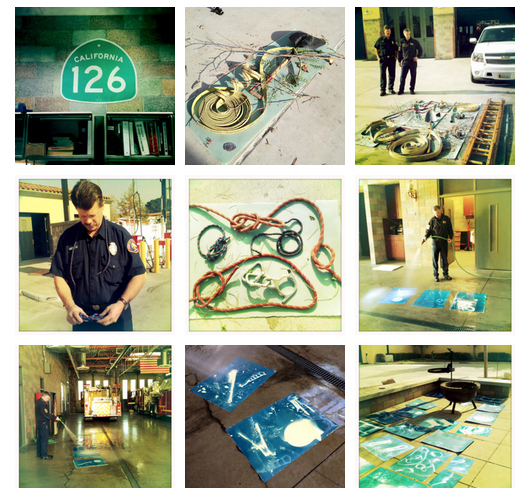
Cyanotypes and knots made with the help of firefighters from Fire Station 132, 2012
AL
I’m continually struck by how your work evolves. You have maintained a certain aesthetic, but are infinitely playful with your methods and materials. In your newest works, you use your photo-based 2-D pieces to make dimensional reliefs, which are reminiscent of origami. What is the process for those pieces?

Fractals I, 2013, spray paint and cyanotype on cut and folded paper, 22 x 30 x 15 inches
CN
I work on the paper surface first, and then do the cut and folds and sometimes work on the surface more. Another thing on my to do list is to make big paper fractals and encrust them with salt crystals.
AL
All of this makes me think of how artists need to continually reinvent themselves. Is this partially based on boredom? Do you ever fear that you’ll run out of ideas?
CN
I think I’m always exploring and it’s about keeping your blood pumping because you’re excited. I am very much tied to all the various process I’m interested in and if I move onto something else, it’s not necessarily out of boredom. I see it as an ongoing process; expanding and growing as an artist.
AL
What are you working on now?
CN
Right now I am still drawing on Mylar, growing salt crystals, and experimenting with cyanotypes and paper folding.
Planetary Rays, 2013, salt crystals, spray paint, on unprocessed paper with some with sand or dirt, approximately 20 x 20 inches
Folding Space, 2013, salt crystals, spray paint, on unprocessed paper with some with sand or dirt, approximately 20 x 20 inches
AL
In addition to everything else you make, you recently put out an album. How does making music fit into your art making? Does one creative endeavor inform the other, and vice-versa?
CN
I recently put out an album, “Sea Moon She,” on bandcamp.
I’m in the process of making CDs, including a limited edition with artwork.
It was years in the making, as I’ve been learning how to record and play instruments. It’s been a great process. This album has a few songs where friends have contributed to some tracks. In ‘Time Travelling,’ Tai Tajima played the casio sk-1, glockenspiel, toy piano, and melodica with Michael Zirbes on drums, Chris Fifield played the second guitar in ‘Capturing the Invisible,’ and Azeem Khan played guitar, adding some electronic percussions and vocals on ‘Cave Moon Box.’ I’m excited about the next album. I want to try vinyl as the final product and to work with my friends more.
I see music as an extension of my art practice and have been going under the name Sea Moon / Sea Moon She which is referential of my art works. I have been playing with other musicians such as Michael Wysong, Azeem Khan, and Hiro Makino and it’s been a good experience.
AL
Have you ever exhibited your works with your own soundtrack? Have you ever thought about doing a sound installation?
CN
I have performed at the same venue in which my artwork has been shown, and see it as an extension in that regard, but haven’t really thought about doing a sound installation. I’d like to explore video or film in the near future.
Performance with Michael Wysong, 2013, Sam Francis Gallery, Crossroads School for Arts and Sciences, Santa Monica, CA
AL
You have a full time job at the J. Paul Getty Museum as well. How do you make time for all of your interests? Do you alternate back and forth between visual art and music, or are those two symbiotic for you? Do you have down periods where you aren’t producing as much?
CN
I’m a photographer at the Getty Research Institute in the Digital Services department and work part time, which helps a lot. I photograph the special collection materials in the GRI primarily for publications and for out going exhibitions, but also make facsimiles and the occasional portraits of scholars etc..
I’m not sure I have enough time for all of my interests! I do go back and forth between projects. I see music as part of my art, so I don’t distinguish between them as far as working. When I’m not producing much, I’m working on something like landscaping or gardening. Basically, there’s always something to work on!
Artist’s garden, Long Beach, CA
Christine Nguyen lives in Long Beach, California. Solo exhibitions of her work have been featured at the Hammer Museum (Project), Michael Kohn Gallery, Andrewshire Gallery, and 10 Chancery Lane Gallery, Hong Kong.
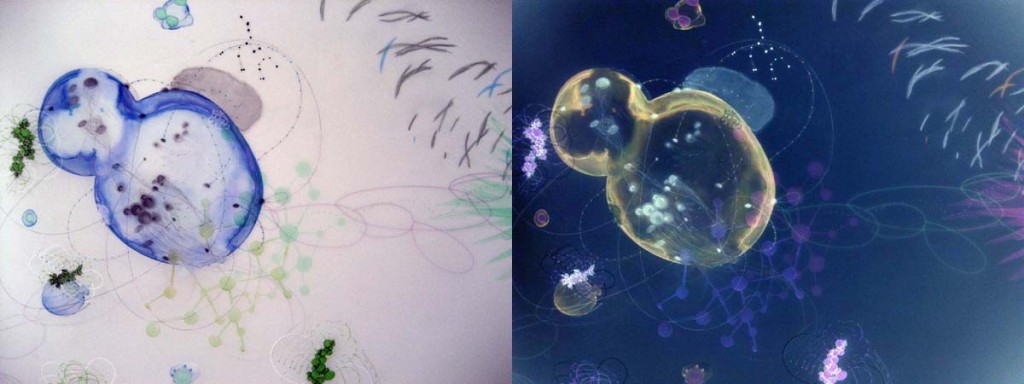

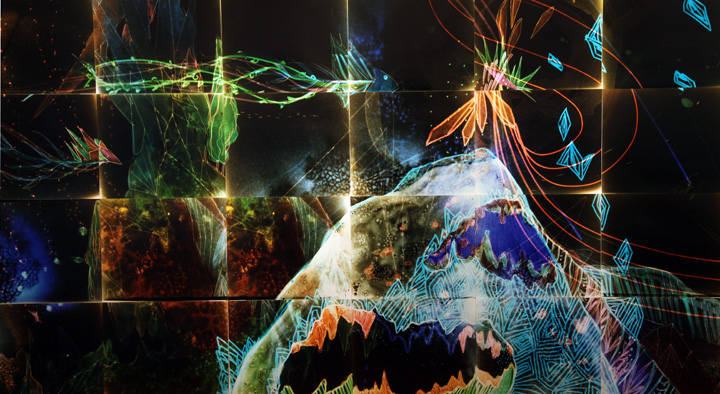
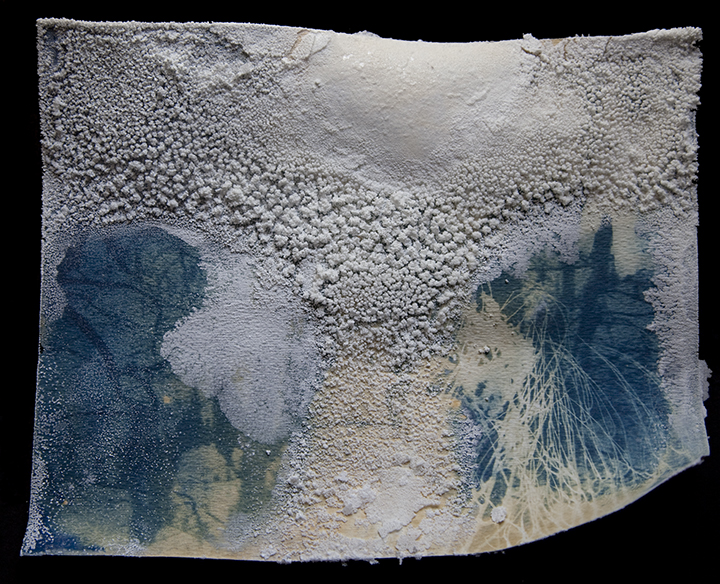
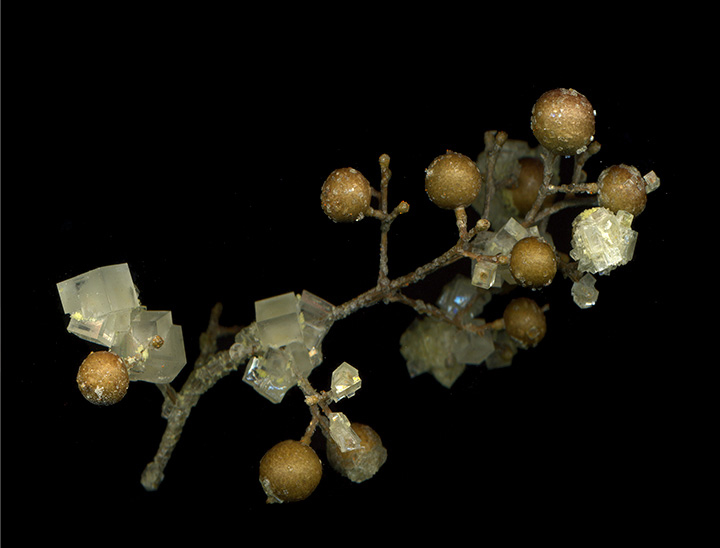

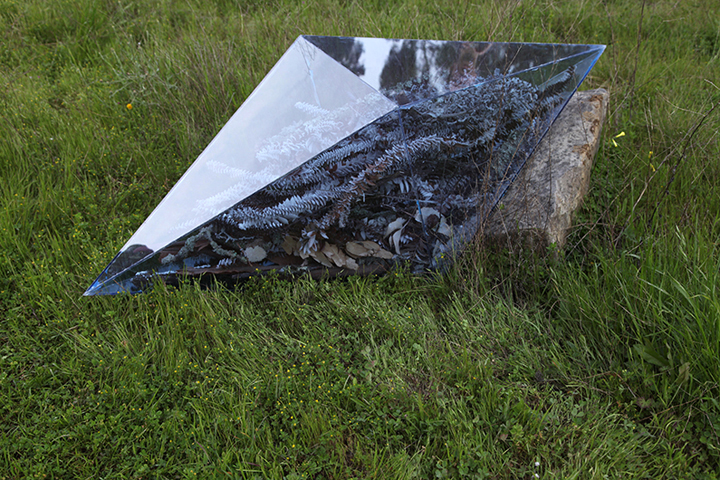



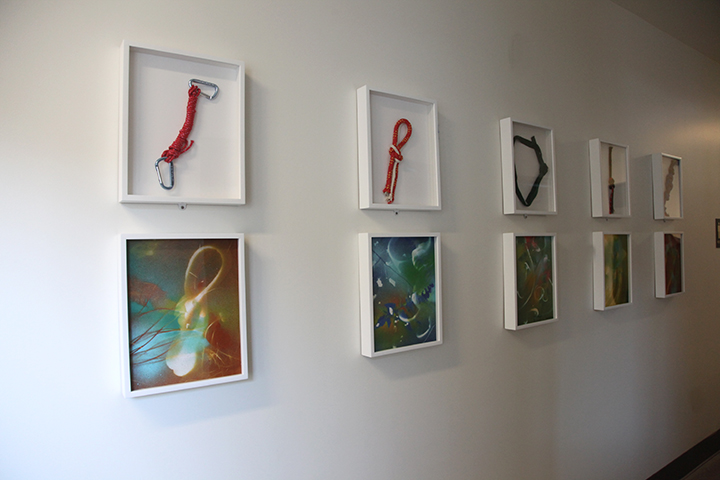
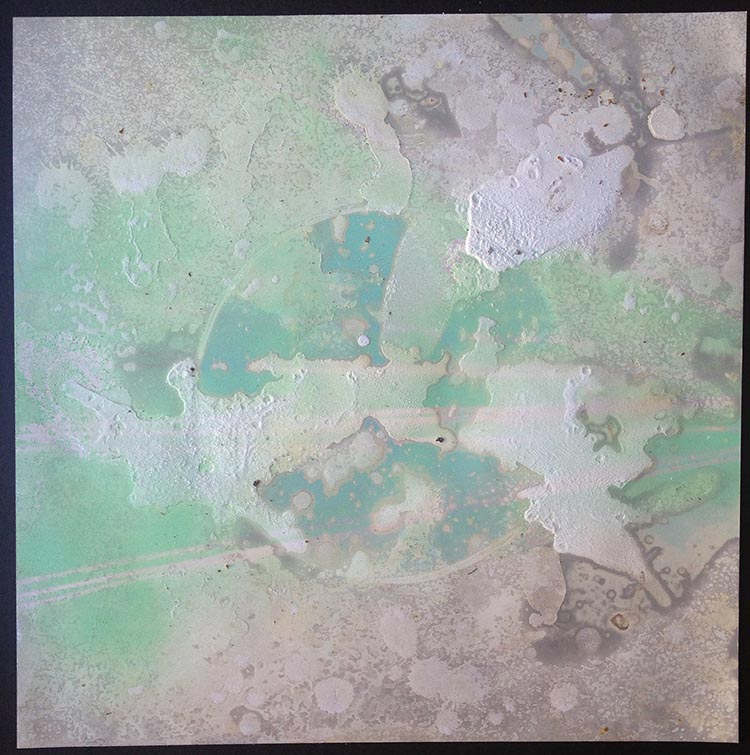
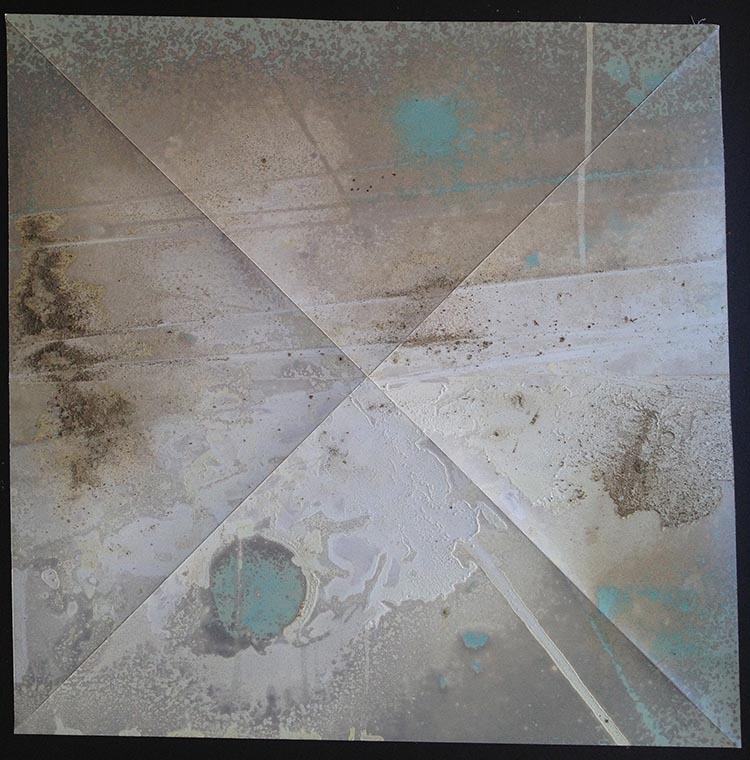

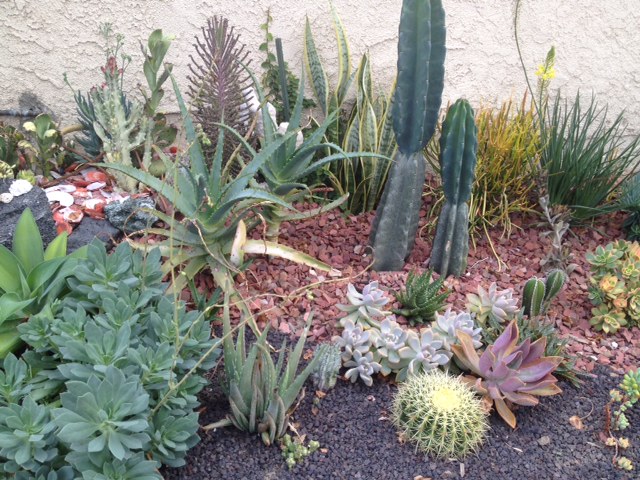
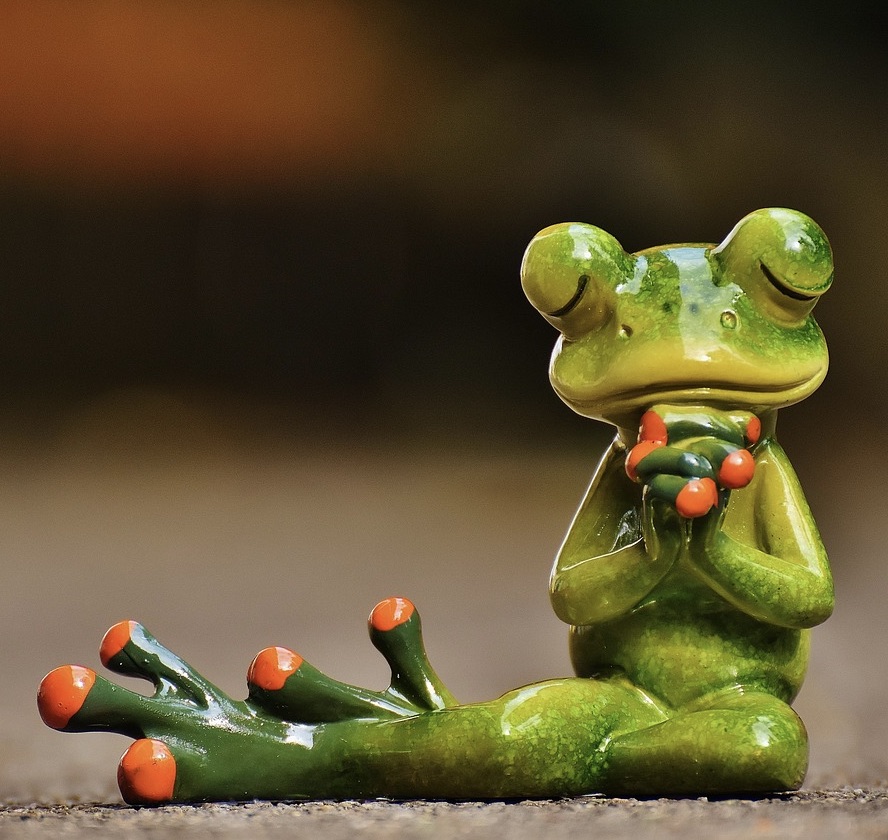
![Monument for Inger Christensen. Photo by David Stjernholm. Featured image for [o] by Kristi Maxwell.](https://atlengthmag.com/wp-content/uploads/2025/06/Monument-for-Inger-Christensen_Kaare-Golles_002_Photo-by-David-Stjernholm-1280x914-1.jpg)
